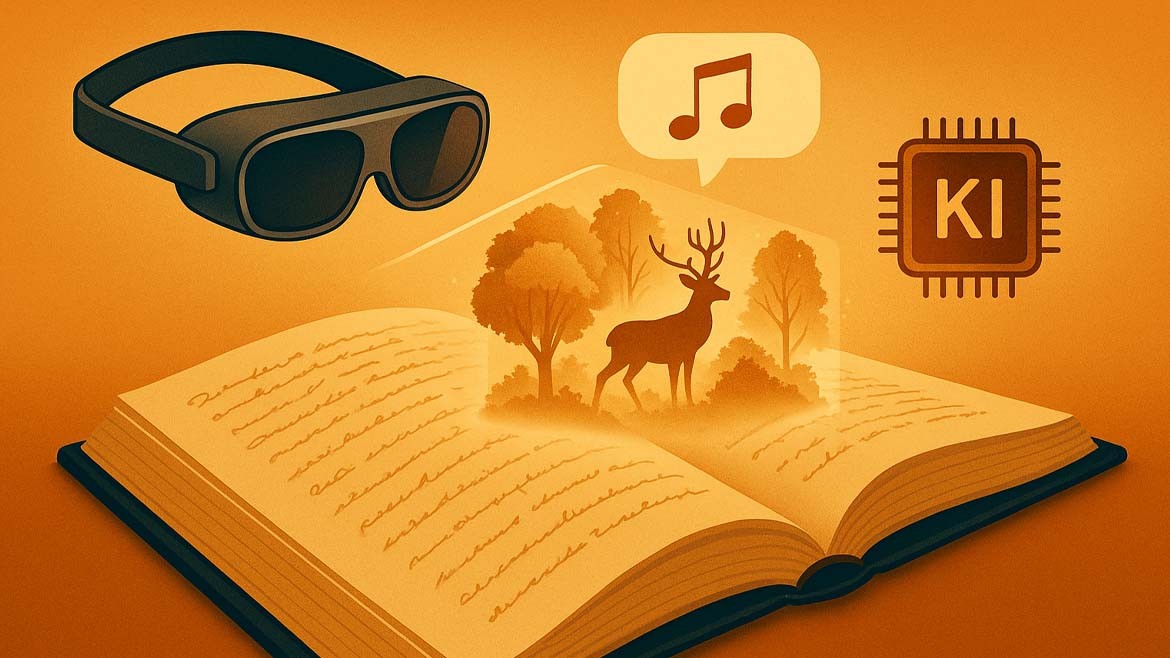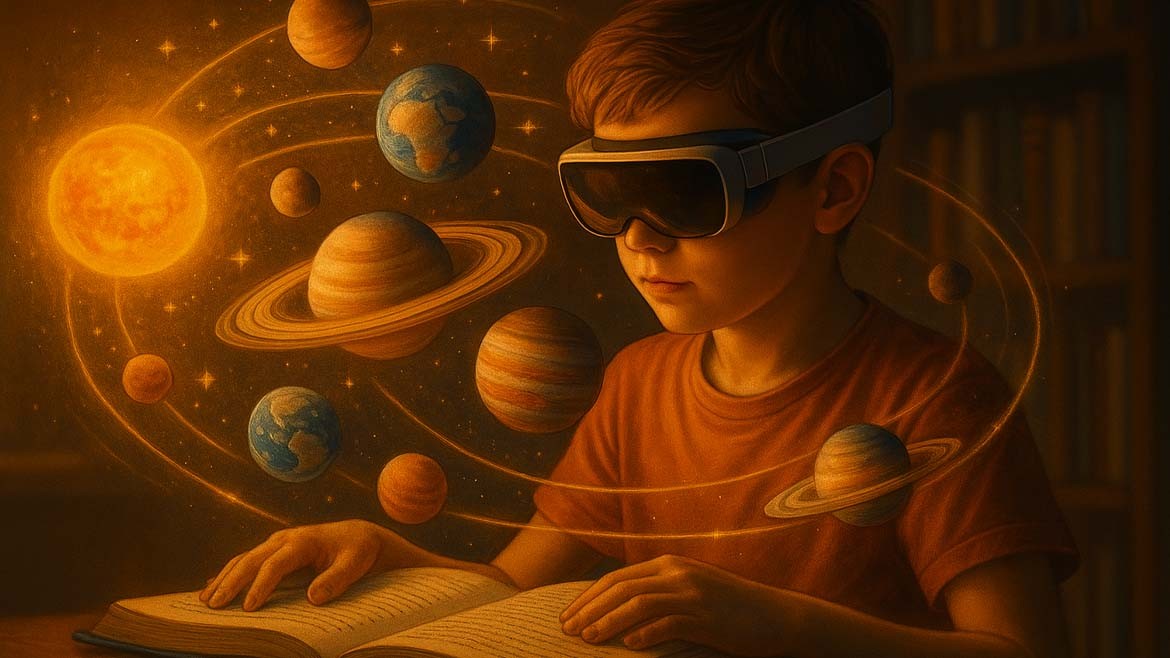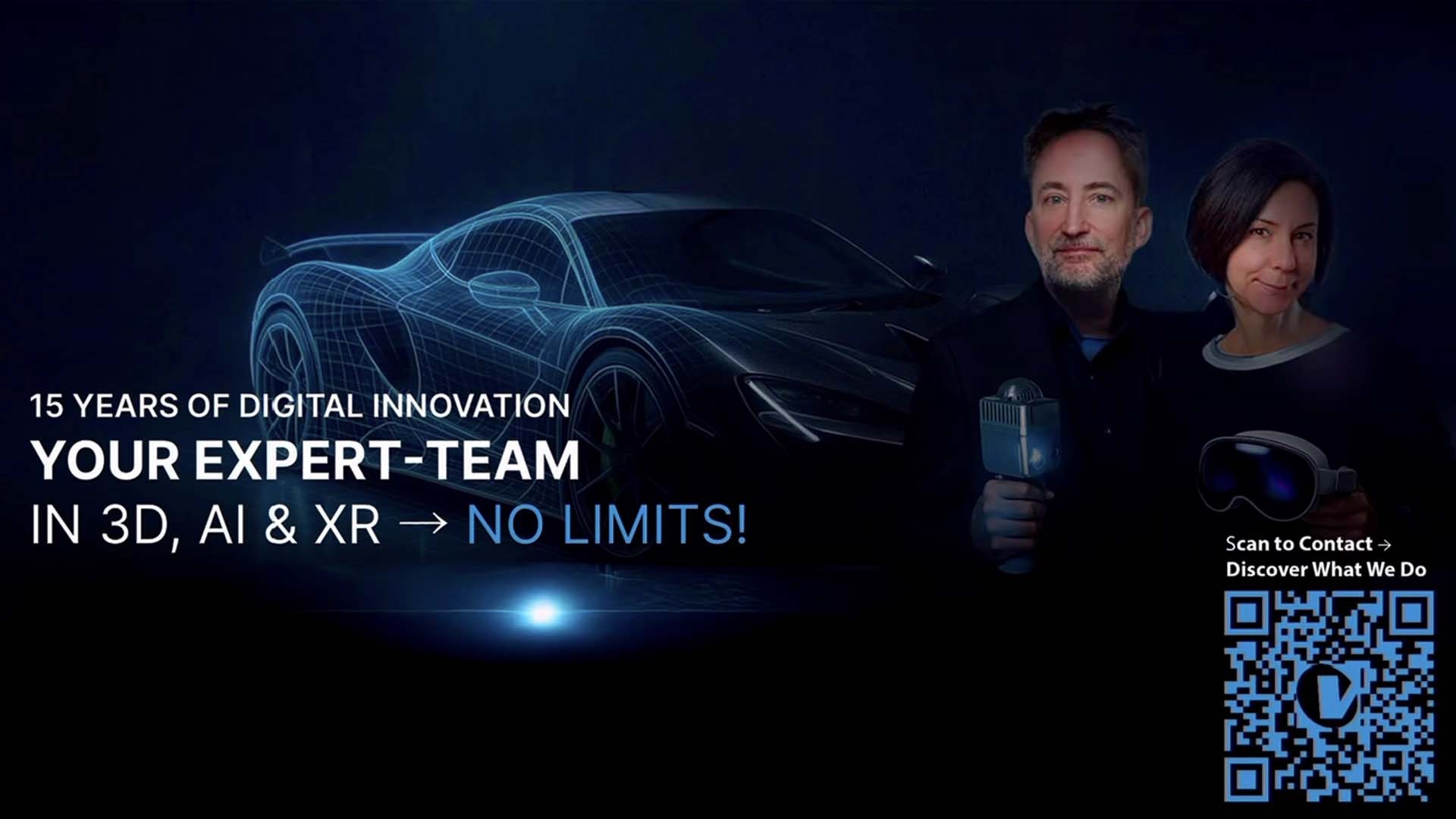A digital penguin on an ice floe rises from the book page – a symbolic representation of immersive reading experiences with AI and Augmented Reality.
Visualization: Ulrich Buckenlei | VISORIC GmbH, 2025
The Moment When Books Come Alive
What if books were not only read but experienced? The next generation of reading technology combines Augmented Reality with Artificial Intelligence – transforming traditional books into interactive experience spaces. Readers wear AR glasses with closed optics that project content directly onto the real book page. AI recognizes in real time what subject is being read – and overlays matching 3D visualizations, sounds, or animations. The book becomes a stage for intelligent productions.
- AR glasses project digital content directly onto the book page
- AI analyzes topic, pace, and emotional tone of the reading
- Readers experience stories as visual-emotional spaces
- A new approach to education, storytelling, and knowledge transfer
Through this immersive fusion of analog reading and digital augmentation, a completely new form of immersion emerges. The book does not only speak to the mind but engages all senses – supported by real-time technology that intuitively adapts to the behavior of the readers.

A glimpse into the future of reading: The combination of AI, AR glasses, and traditional books creates a completely new storytelling experience.
Visualization: Instagram @aiworldbyrai | VISORIC GmbH, 2025
The technology is already on the starting line. What still seems like science fiction today could soon become part of everyday life – whether in classrooms, children’s rooms, or literary reading. The future of reading is hybrid, interactive, and full of insight.
When AI Understands What We Read
The next level of reading begins in the invisible: While we dive into a physical book with AR glasses, an AI analyzes in the background in real time which content captures our attention. Eye-tracking, reading pace, and even micro-reactions such as pupil movement or facial expressions help the technology understand what moves us – and how we respond to what we read.
Based on this data, context-based content is generated: a subtle soundtrack, a visual scene on the book page, or a 3D animation that visually interprets the text. Artificial intelligence does not simply translate text into images – it “empathizes,” recognizes moods, and dynamically adapts its reactions.
- Semantic analysis detects themes, emotions, and tension arcs
- AR visualizations adapt to reading pace and mood
- Eye-tracking enables precise mapping of text and gaze
- Adaptive content through AI-generated 3D scenes and soundscapes
This creates an entirely new form of reading, where technology does not disturb but accompanies – almost invisible and yet powerful. The boundary between imagination and reality blurs as letters come alive and stories literally rise from the page.

While reading, AI analyzes the context and generates matching visual content in real time – directly above the book page.
Visualization: Ulrich Buckenlei | VISORIC GmbH, 2025
This dynamic connection of text, technology, and emotion not only creates an immersive experience but also enables entirely new educational approaches – from childlike curiosity to advanced academic literature. The book becomes an experience space, the AI a silent narrator in the background.
When Stories Come Alive
In this new era of reading, the book is no longer a passive medium – it becomes a stage for interactive worlds. With AR glasses and AI, stories come alive: characters step out of the pages, settings unfold in the room, emotions are visually amplified. Readers are no longer just observers but active participants in the storyline.
Children’s books reveal the enormous potential in particular: instead of just reading, children discover the adventures of characters directly before their eyes – adapted to their age, pace, and reactions. This creates a new emotional understanding of narrative, language, and content.
- Story elements unfold visually in space
- Characters dynamically respond to reading progress
- Children experience content playfully and immersively
- AI adapts presentation to concentration and mood
This new dimension of reading combines pedagogical concepts with technological innovation. The result: an experience that connects learning, emotion, and imagination in entirely new ways – motivating children to dive deeper into the world of books.

A child reads a book – and the story comes alive: Thanks to AI analysis and Augmented Reality, fantasy worlds become visible in real time above the book page.
Visualization: Ulrich Buckenlei | VISORIC GmbH, 2025
What used to rely on imagination alone is now made visible and tangible. This development could radically change not only how we tell stories but also how we learn, feel, and educate ourselves.
A New Level of Emotional Reading
While classic books rely on words to convey emotions, the combination of **AR glasses and AI** opens a new dimension: content is not only visualized but intensified emotionally. The technology detects tension arcs, shifts in themes, and emotional peaks – and reacts in real time.
Readers not only experience a story but feel it more directly and deeply. Colors, lighting, movement, and sound respond to what is read. A quiet moment becomes visually calming, a dramatic twist accompanied by vibrating dynamics. The book becomes a stage, the text the director of an immersive performance.
- Emotional dynamics visually amplified
- Adaptive lighting and color worlds matching the narrative
- Music and soundscapes as mood-shaping elements
- Storytelling with emotional depth and immersive flow

Making emotions visible: AR and AI enhance the reading experience through dynamic mood visualization and adaptive environmental effects.
Visualization: Ulrich Buckenlei | VISORIC GmbH, 2025
What used to be sensed only between the lines is now made visible and tangible – without changing the written word. The technology stays invisible in the background, leaving space for a deeply moving, personal experience of stories. A new era of reading begins – sensory, empathic, profound.
How could such an AI-supported reading experience look in practice? The following video shows one of the most exciting prototypes from the Mega Trend Hackathon in action: an interactive book page that uses AI to recognize content, visually interpret it, and display matching AR elements in real time – adapted to reading speed, context, and emotion.
Through precise text recognition, semantic analysis, and visual generation, readers not only experience a story but step into it. The boundaries between book, stage, and consciousness begin to blur.
Rediscover Reading – The Prototype Video
The video showcases the impressive implementation of the interactive book concept developed during the hackathon. Within a short time, a functional prototype was created that combines technological sophistication with creative storytelling. AR glasses, computer vision, and generative AI work hand in hand – for an experience that completely surrounds the reader.
Immersive storytelling in action.
Source: Instagram @aiworldbyrai | VISORIC GmbH, 2025
This video is more than a recap – it is a glimpse into the future of reading. A future where text is no longer just read but fully experienced – emotional, interactive, and individual.
Ulrich Buckenlei and the VISORIC Expert Team
Ulrich Buckenlei, CEO of VISORIC, has been a pioneer in innovative technologies at the intersection of XR, AI, and digital visualization for more than fifteen years. With his expert team in Munich, he supports companies, agencies, and institutions in developing immersive solutions – from the first vision to ready-to-use applications. The focus is always on tangible results: creative, functional, market-oriented.
- Immersive reading technologies with AR, MR, and generative AI
- Development of intuitive interfaces for interactive experiences
- Real-time 3D applications and digital twins for marketing & industry
- XR concepts for storytelling, education, training, and product visualization
If you are interested in immersive technologies, innovative interfaces, or digital products, the VISORIC expert team is your experienced partner. Together we develop customized concepts and realize visionary applications with genuine added value for your company.

Ulrich Buckenlei and Nataliya Daniltseva from the VISORIC Expert Team discussing immersive future technologies. Photo: VISORIC GmbH, 2025
Our work begins with the creative idea – and ends only when your solution reaches the user live. Whether interactive prototypes, immersive book experiences, or production-ready XR products: We combine technological excellence with design expertise and strategic thinking. For experiences that move – and work.
Do you want to take your own idea to the next level? Then get in touch with us.
Contact Persons:
Ulrich Buckenlei (Creative Director)
Mobile: +49 152 53532871
Email: ulrich.buckenlei@visoric.com
Nataliya Daniltseva (Project Manager)
Mobile: +49 176 72805705
Email: nataliya.daniltseva@visoric.com
Address:
VISORIC GmbH
Bayerstraße 13
D-80335 Munich


